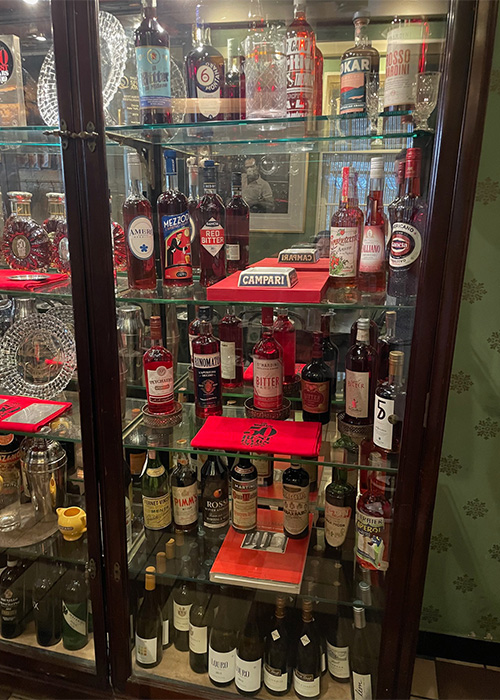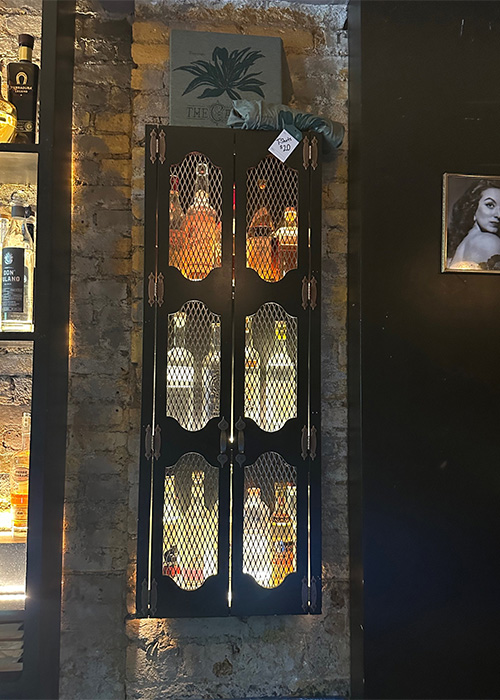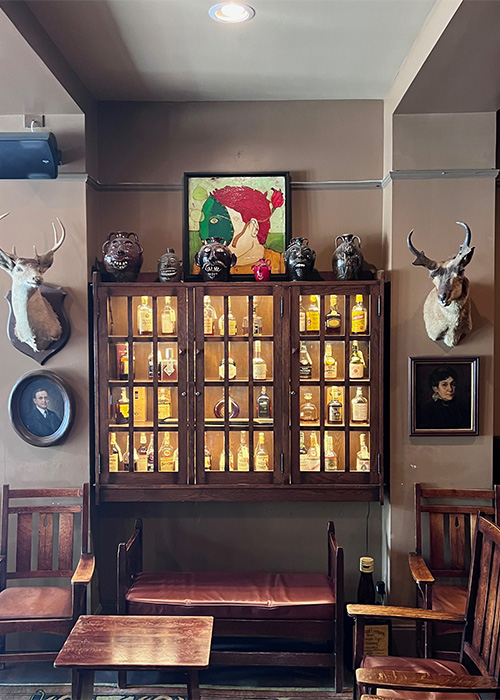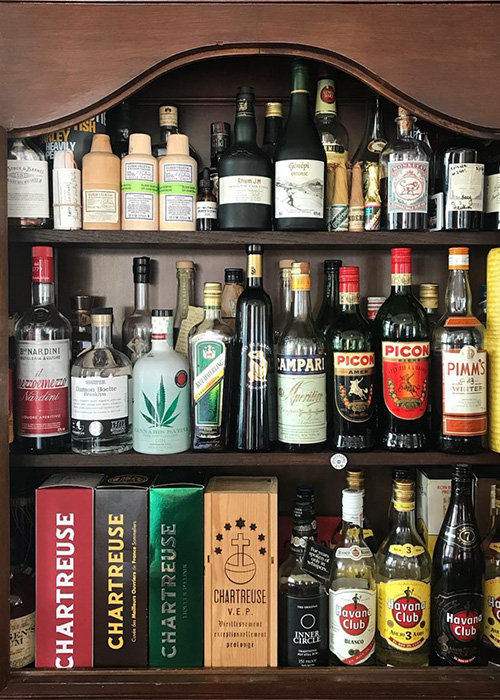It’s not unusual these days to encounter vintage spirits at a bar, whether it’s by way of a neat pour or a special-occasion Vieux Carré composed of ingredients dating back to the 1950s. Bars like The Office in Chicago and Canon in Seattle have helped pioneer the vintage spirits experience, though it’s one that can admittedly be rather spendy. Canon carries a collection of 4,000 labels and counting, and on its Captain’s List you’ll find absinthe, Armagnac, whiskey, and liqueurs through the ages, including a circa-1890 Amer Picon for $950 a pour.
You can also order an $80 vintage Negroni at New York’s Caffe Dante, stirred to perfection with Plymouth Gin, Campari, and Cinzano Rosso Vermouth from the 1970s, but you may also notice some collectible bottles that aren’t available for sampling. Along the cafe’s back wall stand a series of glass cabinets that resemble a college trophy case, except alongside the many awards the bar has won over the years are bright bottles of red bitters along with other unique antique spirits.
Don’t Miss A Drop
Get the latest in beer, wine, and cocktail culture sent straight to your inbox.
“Our cabinet of curiosities was a place we’d store bitters, amaro, and vermouth from our travels. Some vintage, some favorites, and some weird bottles we liked the look of,” says Linden Pride, principal at Dante. “In the early days, there weren’t as many Italian bitters and vermouth in the States, so it became a museum of sorts. It’s a perfect homage to the rich history of Caffe Dante and the parade of characters that have sat between these four walls.”
“Since there isn’t a place to find a steady supply of older bottles we are always on the hunt and tend to pounce on any old bottles we come across.”
Once you start to take notice, you’ll see more nooks and cubbies in the wild that warrant your attention. Some of these unique offerings enjoy — nay, demand — their own devoted menu. Others are hiding in plain sight, just waiting for the right guest to notice, whether it’s a whiskey aficionado or someone wanting to celebrate with something special. These (often hidden) cabinets of curiosities hold the power to establish a connection between the bar and its guests, often revealing more about the bar owners themselves.
Tasting History With Vintage Amaro
One Fifth, the Italian restaurant from chef Marc Forgione in New York’s Greenwich Village, is so devoted to amari that it carries at least one bottle for each of Italy’s 20 regions. “We wanted to showcase every region to provide a new way for guests to connect to what they are drinking and highlight the regionality and how it has influenced the various styles,” says Sabato Sagaria, a founding partner of the New York City-based hospitality company Apres Cru Hospitality, which includes One Fifth.
That fact alone would be enough to attract amaro devotees to One Fifth’s “Piano Bar,” where those 20 bottles stand atop an old piano, but Sagaria has also built an extensive collection of vintage amari and Italian liqueurs that are stored in a screened cabinet in the dining room.
“Building a vintage collection actually wasn’t part of our initial plan, I just got really carried away,” admits Sagaria, who assembled his impressive collection of bittersweet dusties while traveling in Italy and at auctions. “Since there isn’t a place to find a steady supply of older bottles we are always on the hunt and tend to pounce on any old bottles we come across.”
The Chicago bar Billy Sunday places a similar focus on amaro and vintage spirits, but its detailed educational events and tastings also include deep dives on Japanese whisky and single-malt Scotch.
Kris Peterson, the bar’s spirits archivist, likes to let the more obscure, vintage bottles tell their own stories. He notes that even if a guest doesn’t end up buying a pour, simply holding a mid-century bottle in their hands is an experience. From the weight of the bottle to the packaging details, “something transportative happens,” Peterson says.
While Billy Sunday stocks approximately 100 rare and vintage amari expressions — and at least 50 vintage bottles comprising rum, gin, tequila, and rye — among the warren of glass cabinets above the back bar there’s a section devoted expressly to fernet, the subcategory of amaro known for its elevated level of alcohol and more pronounced bitter taste. It’s there where guests will discover 21 different vintage expressions of fernet, including a by-decade vertical with bottles representing each decade dating back to the 1940s.
These live on a reserve list called “The Good Book,” with around 100 options, including gems such as Fernet Vittone from the 1940s and 1950s. “There probably aren’t a ton of back bars in the U.S. lined with vintage Ferent Vittone,” Peterson says. “Their recipe got to market a couple of years ahead of Branca, which always makes for a fun talking point.”
Chasing Chartreuse
After an acclaimed, decade-long run, Pouring Ribbons closed the doors of its second-floor, Lower East Side bar on April 4, 2022. Yet the aromatic memories of the bar’s deep collection of Chartreuse — the storied herbal elixir with 130 secret herbs and botanicals that’s been made by Carthusian monks in Aiguenoire, France, since 1737 — still lingers.
Joaquín Simó, an opening partner at the bar, notes that it was fellow partner Troy Sidle who originally spearheaded the bar’s Chartreuse program, inspired by an after-dinner tasting flight at The Office. “We were looking for a way to stand out as a bar beyond cocktails,” Simó recalls. The allure of celebrating vintage Chartreuse was a learning curve for staff and guests alike, but its niche appeal would prove to be more popular than they imagined.
The Pouring Ribbons team started building their Chartreuse collection at a time when you could still find and purchase bottles on pre-restrictions eBay (you were technically buying the glass bottle as a collectible and not the liquid, and lucky you if it happened to be unopened and filled with booze), through private dealers, estate sales, and even liquor stores.
The Chartreuse collection resided in a cabinet behind the bar with an additional 15 older bottles running three deep on a high shelf along the back bar. These ornate bottles became both a focus and talking point of the bar, as well as a destination for Chartreuse-savvy sommeliers, bartenders, and aficionados.
Simó and his team carried current Chartreuse expressions like the Green, Yellow, and their respective VEP bottlings, along with a deep collection of rare bottles from the 1950s through the 2000s that varied in price from $25 to $200 for a 1-ounce pour. “We had Chartreuse dating back to the 1930s, which were some of the first bottles depleted, along with unicorn juice from the 1940s and 1950s,” Simó says.
Unlike many bars lost to the pandemic, Simó and team were able to leave New York’s bar scene on their own terms, and Pouring Ribbons’ final weeks were a celebration. Curated Chartreuse flights with accompanying detailed tasting and historical notes written by Simó were among the first to sell out. “It took the better part of a decade, but we certainly went through it all,” Simó says. (A selection of the Chartreuse that were either special gifts or bottles he wanted to hang on to remain in Simó’s personal collection — who can deny him that?)
Spirits With Stories
Over at The Cabinet, a two-room temple devoted to agave spirits on New York’s Lower East Side, one room focuses on cocktails while the other plays host to a more intimate experience, with specialized spirits flights and educational classes and events. The bar proudly claims to offer the most comprehensive collection of agave spirits outside Mexico, with a more than 1,100-bottle collection, including over 500 unique mezcals.
“This was my personal collection of things we weren’t necessarily selling, but letting people try for education.”
Agave spirits are a passion for owner Greg Boehm, and the deep selection on display blossomed from his own 20-bottle collection of agave distillates, which take pride of place in an illuminated cabinet behind the bar.
“It’s the reason the bar was called The Cabinet,” Boehm says. “This was my personal collection of things we weren’t necessarily selling, but letting people try for education.” While that original cabinet still holds a few bottles of some of his favorite ryes, these days Boehm admits that mezcal and other agave spirits account for 99 percent of his personal consumption.
When traveling was sidelined during the pandemic, he began a series of pen-pal-esque relationships, practicing his Spanish while corresponding with producers and experts alike, many based in places in Mexico that he would never be able to easily access.
During a recent sit-down with Boehm, he waves a hand, scanning the hundreds of bottles of mezcal, tequila, sotol, raicilla, and bacanora in the tasting room, including a whole shelf of hand-labeled, recycled plastic 1-liter water bottles filled with mezcal brought directly from distillers. “There isn’t a bottle here that we can’t tell you who the producer is, how it was made,” he says. “Every bottle has a personal story.”
In Chapel Hill, N.C., awaits another tale of a bar built from a personal passion. Gary Crunkleton opened his namesake bar, The Crunkleton, in 2008, with an eye-catching 30-foot bar and a back bar of ceiling-scraping 10-foot-high bookshelves stacked with more than 620 unique bottles heavy on whiskey, the proprietor’s favorite spirit. “If it’s not worth drinking it’s not up on the wall,” Crunkleton says.
But even more impressive among that wall of spirits is the elevated Mission Oak cabinet, located just to the left of the room when patrons first walk in, with over a dozen bottles of vintage bourbon and rye from his extensive collection. These are available to sample from $60–$700 for a 1.5-ounce pour and include dusties like Old Kentucky No. 88 Brand 13-year straight bourbon whiskey distilled in 1975 and bottled in 1988 and W. L. Weller 10-year, 110-proof straight bourbon whiskey distilled in 1952 and bottled in 1962 from the Stitzel-Weller Distillery in Louisville.
“It’s the nostalgia of it all that tells the story.”
“I wanted to be the Jack Rose of the South,” says Crunkleton, referencing the Washington, D.C., saloon that has one of the largest whiskey selections in the Western Hemisphere. But sharing these rare bottles with guests was a challenge in North Carolina, one of the country’s 17 control states. Crunkleton’s dedication and advocacy for rare spirits paid off in the long run, though, when he helped educate and lobby the North Carolina General Assembly, which, in 2015, passed House Bill 909, which permitted the “sale of antique spirituous liquor” in bars, restaurants, and distilleries.
These rare bottles in the cabinet (thanks to the “Crunkleton Bill”) aren’t listed on a printed menu or accessed through a QR code. Instead, Crunkleton wants guests to engage with a bartender to learn more about the selections on offer. “We tell them more about the history of the bottle,” he says. “It’s the nostalgia of it all that tells the story.”
Will the Circle Be Unbroken?
Perhaps one of the more personalized collections within a bar is the “Bosses’ Cabinet” at Brooklyn’s Grand Army. This spirited, glass-windowed cubby was created by the bar’s co-founder, Damon Boelte, when the bar first opened in 2015.
Open its doors and you might uncover unique bottles of rye like Red Hook Rye from Boelte’s time working at LeNell’s LTD and first-edition samples of Lock, Stock and Barrel, a gift from the late distiller Rob Cooper; boxed bottles of Chartreuse shepherded back directly from the distillery in France; experimental batches from the late master distiller Dave Pickerell; antique bottles of Underberg from the 1950s through the 1980s; and one of Boelte’s favorites, a bottle of first-edition Monkey 47 Sloe Gin, signed by brand ambassador Lacy Hawkins.
Nothing in the Cabinet was ever for sale, but always available to taste for those willing to sit through a campfire tale from Boelte about the history of the particular bottle. For Boelte, it was always about creating and honoring meaningful moments.
“These are the keepsakes of my life and travels in this industry. Rarities abound, but some bottles don’t necessarily have to be rare, just special” he says. “Each bottle tells their own story, and they are all especially important to me.
Boelte’s so-called “mini museum” was tucked away in a safe place during the pandemic so Grand Army could devote the prime real estate to products that could actually sell to guests.
With Boelte now living on the West Coast, the future of the Bosses’ Cabinet is uncertain but, as he says, “the collection still resides.”
“I know that it might sound kind of crazy for a bunch of bottles of alcohol to have such deep meaning, but people collect lots of things,” Boelte says. “Each bottle tells their own story, and they are all especially important to me. With these, I can continue the story with more friends, old and new, until the bottle runs dry.”






